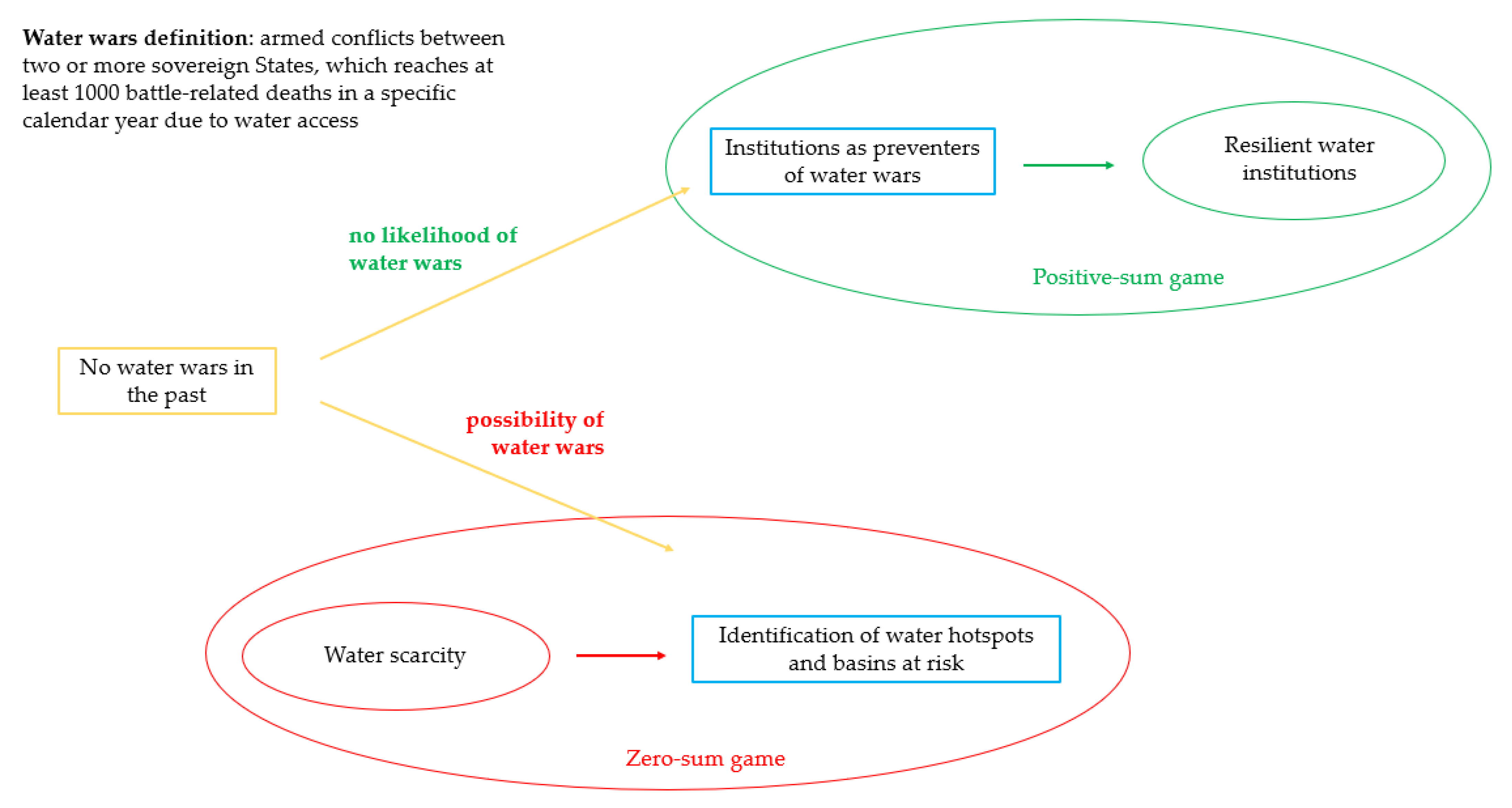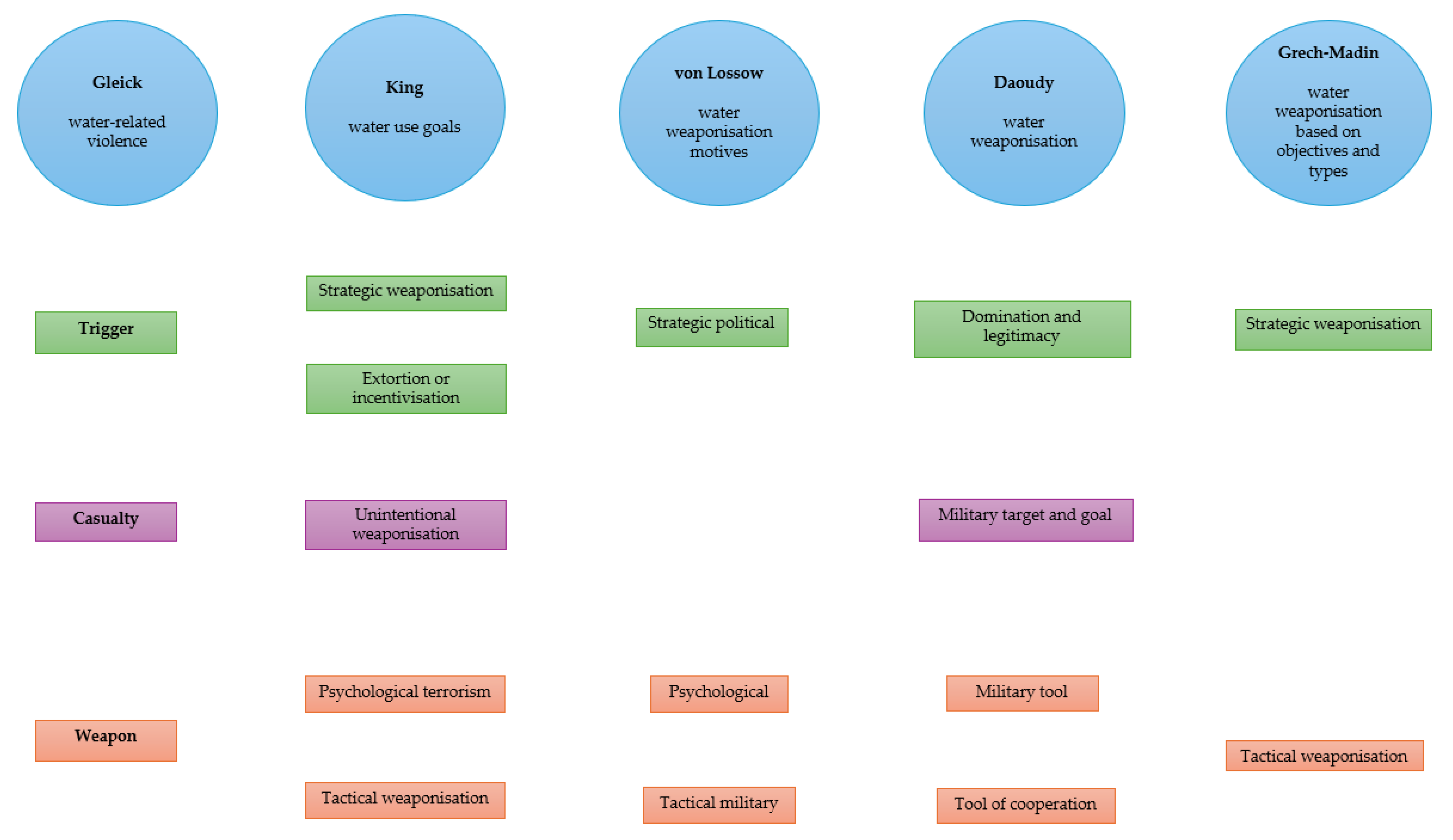Reviewing Water Wars and Water Weaponisation Literatures: Is There an Unnoticed Link?
Abstract
1. Introduction
2. Literature Review
2.1. Water Wars
2.2. Water Weaponisation
3. Discussion
Author Contributions
Funding
Data Availability Statement
Conflicts of Interest
Abbreviations
| BC | Before Christ |
References
- Serageldin, I. Water wars? A talk with Ismail Serageldin. World Policy J. 2009, 26, 25–31. [Google Scholar] [CrossRef]
- Shiva, V. Water Wars: Privatization, Pollution and Profit; South End Press: Boston, MA, USA, 2002. [Google Scholar]
- Yoffe, S.; Wolf, A.T.; Giordano, M. Conflict and cooperation over international freshwater resources: Indicators of basins at risk 1. JAWRA J. Am. Water Resour. Assoc. 2003, 39, 1109–1126. [Google Scholar] [CrossRef]
- Wolf, A.T.; Yoffe, S.B.; Giordano, M. International waters: Identifying basins at risk. Water Policy 2003, 5, 29–60. [Google Scholar] [CrossRef]
- Wolf, A.T.; Stahl, K.; Macomber, M.F. Conflict and cooperation within international river basins: The importance of institutional capacity. Water Resour. Update 2003, 125, 31–40. [Google Scholar]
- Gleick, P.H. Water as a weapon and casualty of armed conflict: A review of recent water-related violence in Iraq, Syria, and Yemen. Wiley Interdiscip. Rev. Water 2019, 6, e1351. [Google Scholar] [CrossRef]
- King, M.D. The weaponization of water in Syria and Iraq. Wash. Q. 2015, 38, 153–169. [Google Scholar] [CrossRef]
- Daoudy, M. Water weaponization in the Syrian conflict: Strategies of domination and cooperation. Int. Aff. 2020, 96, 1347–1366. [Google Scholar] [CrossRef]
- McCracken, M.; Wolf, A.T. Updating the Register of International River Basins of the world. Int. J. Water Resour. Dev. 2019, 35, 732–782. [Google Scholar] [CrossRef]
- Ballatore, T.J.; Muhandiki, V.S. The case for a world lake vision. Hydrol. Process. 2002, 16, 2079–2089. [Google Scholar] [CrossRef]
- Van der Gun, J. Large Aquifer Systems Around the World; The Groundwater Project: Guelph, ON, Canada, 2022. [Google Scholar]
- UCDP. UCDP Definitions—War. The Uppsala Conflict Data Program. Available online: https://www.uu.se/en/department/peace-and-conflict-research/research/ucdp/ucdp-definitions (accessed on 8 December 2024).
- Postel, S.L.; Wolf, A.T. Dehydrating conflict. Foreign Policy 2001, 126, 60–67. [Google Scholar] [CrossRef]
- Priscoli, J.; Wolf, A.T. Managing and Transforming Water Conflicts; Cambridge University Press: Cambridge, UK, 2009. [Google Scholar]
- Wolf, A.T. The transboundary freshwater dispute database project. Water Int. 1999, 24, 160–163. [Google Scholar] [CrossRef]
- Wolf, A.T. Criteria for equitable allocations: The heart of international water conflict. In Natural Resources Forum; Blackwell Publishing Ltd.: Hoboken, NJ, USA, 1999; Volume 23, pp. 3–30. [Google Scholar]
- Petersen-Perlman, J.D.; Veilleux, J.C.; Wolf, A.T. International water conflict and cooperation: Challenges and opportunities. Water Int. 2017, 42, 105–120. [Google Scholar] [CrossRef]
- Alcamo, J.; Henrichs, T.; Rösch, T. World Water in 2025-Global Modeling and Scenario Analysis for the World Commission on Water for the 21st Century; Kassel World Water Series; University of Kassel: Kassel, Germany, 2000. [Google Scholar]
- Gleick, P.H. The World’s Water: The Biennial Report on Freshwater Resources 2002–2003; Island Press: Washington, DC, USA, 2002. [Google Scholar]
- Ohlsson, L. Environment, Scarcity and Conflict: A Study of Malthusian Concerns; Department of Peace and Development Research, University of Gothenburg: Gothenburg, Sweden, 1999. [Google Scholar]
- Raskin, P.; Gleick, P.; Kirshen, P.; Pontius, G.; Strzepek, K. Water Futures: Assessment of Long-Range Patterns and Prospects; Stockholm Environment Institute: Stockholm, Sweden, 1997. [Google Scholar]
- Rijsberman, F.R. Water scarcity: Fact or fiction? Agric. Water Manag. 2006, 80, 5–22. [Google Scholar] [CrossRef]
- Seckler, D.; Amarasinghe, U.; Molden, D.J.; de Silva, R.; Barker, R. World Water Demand and Supply, 1990 to 2025: Scenarios and Issues; IWMI: Colombo, Sri Lanka, 1998. [Google Scholar]
- Liu, J.; Yang, H.; Gosling, S.N.; Kummu, M.; Flörke, M.; Pfister, S.; Hanasaki, N.; Wada, Y.; Zhang, X.; Zheng, C.; et al. Water scarcity assessments in the past, present, and future. Earth’s Future 2017, 5, 545–559. [Google Scholar] [CrossRef]
- Falkenmark, M.; Lundqvist, J.; Widstrand, C. Macro-scale water scarcity requires micro-scale approaches. Nat. Resour. Forum 1989, 13, 258–267. [Google Scholar] [CrossRef]
- Alcamo, J.; Doll, P.; Henrichs, T.; Kaspar, F.; Lehner, B.; Rösch, T.; Siebert, S. Global estimates of water withdrawals and availability under current and future “business-as-usual” conditions. Hydrol. Sci. J. 2003, 48, 339–348. [Google Scholar] [CrossRef]
- Oki, T.; Kanae, S. Global hydrological cycles and world water resources. Science 2006, 313, 1068–1072. [Google Scholar] [CrossRef] [PubMed]
- Wada, Y.; Van Beck, R.; Viviroli, D.; Durr, H.H.; Weingartner, R.; Bierkens, M.F.P. Global monthly water stress: II. Water demand and severity of water stress. Water Resour. Res. 2011, 47, W07518. [Google Scholar] [CrossRef]
- Gleick, P.H.; Cooley, H. Freshwater scarcity. Annu. Rev. Environ. Resour. 2021, 46, 319–348. [Google Scholar] [CrossRef]
- Sullivan, C.A.; Meigh, J.R.; Giacomello, A.M. The water poverty index: Development and application at the community scale. Nat. Resour. Forum 2003, 27, 189–199. [Google Scholar] [CrossRef]
- TFDD. The Atlas of International Freshwater Agreements. Transboundary Freshwater Dispute Database. United Nations Environmental Programme. 2002. Available online: https://transboundarywaters.ceoas.oregonstate.edu/sites/transboundarywaters.ceoas.oregonstate.edu/files/2023-08/AtlasFreshwaterAgreements.pdf (accessed on 30 December 2024).
- European Union. Global Drought Risk and Water Stress. Emergency Responde Coordination Centre—DG ECHO. 2019. Available online: https://reliefweb.int/map/world/global-drought-risk-and-water-stress-dg-echo-daily-map-11102019 (accessed on 15 January 2025).
- WMO. 2021 State of Climate Services: Water; World Meteorological Organisation: Geneva, Switzerland, 2021; Available online: https://library.wmo.int/viewer/57630/download?file=1278_en.pdf&type=pdf&navigator=1 (accessed on 8 January 2025).
- Wolf, A.T. Conflict and cooperation along international waterways. Water Policy 1998, 1, 251–265. [Google Scholar] [CrossRef]
- Wolf, A.T. ‘Water Wars’ and Other Tales of Hydromythology. In Whose Water is It? The Unquenchable Thirst of a Water-Hungry World; McDonald, B., Jehl, D., Eds.; National Geographic: Washington, DC, USA, 2003; pp. 109–124. [Google Scholar]
- Hatami, H.; Gleick, P.H. Conflicts over water in the myths, legends, and ancient history of the middle east. Environment 1994, 36, 10–11. [Google Scholar] [CrossRef]
- Carius, A.; Dabelko, G.D.; Wolf, A.T. Water, Conflict, and Cooperation. In Environmental Change and Security Project Report; ECSP: Washington, DC, USA, 2004; pp. 60–66. Available online: https://www.files.ethz.ch/isn/135748/ECSP%20report_10.pdf (accessed on 28 December 2024).
- De Stefano, L.; Edwards, P.; De Silva, L.; Wolf, A.T. Tracking cooperation and conflict in international basins: Historic and recent trends. Water Policy 2010, 12, 871–884. [Google Scholar] [CrossRef]
- Wolf, A.T.; Natharius, J.A.; Danielson, J.J.; Ward, B.S.; Pender, J.K. International River Basins of the World. Water Resour. Dev. 1999, 15, 387–427. [Google Scholar] [CrossRef]
- Rieu-Clarke, A.; Kinna, R. Can two global UN Water Conventions Effectively Co-exist? Making the case for a ‘Package Approach’ to support institutional co-ordination. Rev. Eur. Comp. Int. Environ. Law 2014, 23, 15–31. [Google Scholar] [CrossRef]
- UNECE. Water Allocation Doctrines. United Nations Economic Commission for Europe. Available online: https://unece.org/fileadmin/DAM/env/documents/2017/WAT/10Oct_16-17_WS_on_Water_Allocation/Session_0_Rekolainen_Water_Allocation_Doctrines.pdf (accessed on 30 December 2024).
- Wolf, A.T. Shared waters: Conflict and cooperation. Annu. Rev. Environ. Resour. 2007, 32, 241–269. [Google Scholar] [CrossRef]
- Chalecki, E.L. A New Vigilance: Identifying and Reducing the Risks of Environmental Terrorism. Glob. Environ. Politics 2002, 2, 46–64. [Google Scholar] [CrossRef]
- Cole, A. Weakening of the Nation-State by Climate Change: Water Weaponization by ISIL. Dartm. Undergrad. J. Politics 2021, 1, 135–157. [Google Scholar]
- Veilleux, J.; Dinar, S. A Global Analysis of Water-Related Terrorism, 1970–2016. Terror. Political Violence 2021, 33, 1191–1216. [Google Scholar] [CrossRef]
- Gleick, P.H. Water and terrorism. Water Policy 2006, 8, 481–503. [Google Scholar] [CrossRef]
- Cole, L.A. The poison weapons taboo: Biology, culture, and policy. Politics Life Sci. 1998, 17, 119–132. [Google Scholar] [CrossRef]
- Del Giacco, L.J.; Drusiani, R.; Lucentini, L.; Murtas, S. Water as a weapon in ancient times: Considerations of technical and ethical aspects. Water Sci. Technol. Water Supply 2017, 17, 1490–1498. [Google Scholar] [CrossRef]
- Pacific Institute. Water Conflict Chronology. Available online: https://www.worldwater.org/conflict/list/ (accessed on 20 December 2024).
- Gleick, P.H. Water and Conflict: Fresh Water Resources and International Security. Int. Secur. 1993, 18, 79–112. [Google Scholar] [CrossRef]
- Gleick, P.H.; Shimabuku, M. Water-related conflicts: Definitions, data, and trends from the water conflict chronology. Environ. Res. Lett. 2023, 18, 034022. [Google Scholar] [CrossRef]
- Gama, M. Water Weaponization: The Syrian Case. E-Cad. CES 2023, 40, 29–56. [Google Scholar]
- Gleick, P.H. Water as a Weapon and Casualty of Conflict: Freshwater and International Humanitarian Law. Water Resour. Manag. 2019, 33, 1737–1751. [Google Scholar] [CrossRef]
- King, M.D. Weaponizing Water: Water Stress and Islamic Extremist Violence in Africa and the Middle East; Lynne Rienner Publishers: Boulder, CO, USA, 2023. [Google Scholar]
- von Lossow, T. The Rebirth of Water as a Weapon: IS in Syria and Iraq. Int. Spect. 2016, 51, 82–99. [Google Scholar] [CrossRef]
- Grech-Madin, C. Water and warfare: The evolution and operation of the water taboo. Int. Secur. 2021, 45, 84–125. [Google Scholar] [CrossRef]
- King, M.D.; Burnell, J. The Weaponization of Water in a Changing Climate. 2017. Available online: https://climateandsecurity.org/epicenters/ (accessed on 10 December 2024).
- Euro-Med Human Rights Monitor. Israel Uses Water as a Weapon of Its Genocide in Gaza. 5 July 2024. Available online: https://euromedmonitor.org/en/article/6393/Israel-uses-water-as-a-weapon-of-its-genocide-in-Gaza (accessed on 15 January 2025).
- International Criminal Court. Situation in the State of Palestine: ICC Pre-Trial Chamber I Rejects the State of Israel’s Challenges to Jurisdiction and Issues Warrants of Arrest for Benjamin Netanyahu and Yoav Gallant. International Criminal Court. 21 November 2024. Available online: https://www.icc-cpi.int/news/situation-state-palestine-icc-pre-trial-chamber-i-rejects-state-israels-challenges (accessed on 15 January 2025).
- Samad, L.A.; Butcher, M.; Khalidi, B. Water War Crimes: How Israel Has Weaponised Water in Its Military Campaign in Gaza. 2024. Available online: https://policy-practice.oxfam.org/resources/water-war-crimes-how-israel-has-weaponised-water-in-its-military-campaign-in-ga-621609/ (accessed on 15 January 2025).
- Times of Israel. Rights Group Claims Gaza Water Scarcity Is ‘Act of Genocide’; Israel: ‘Blood Libel’. 19 December 2024. Available online: https://www.timesofisrael.com/rights-group-claims-gaza-water-scarcity-is-act-of-genocide-israel-blood-libel/ (accessed on 15 January 2025).
- United Nations Human Rights Council. Anatomy of a Genocide: Report of the Special Rapporteur on the Situation of Human Rights in the Palestinian Territories Occupied Since 1967, Francesca Albanese (A/HRC/55/73). 2024. Available online: https://www.un.org/unispal/document/anatomy-of-a-genocide-report-of-the-special-rapporteur-on-the-situation-of-human-rights-in-the-palestinian-territory-occupied-since-1967-to-human-rights-council-advance-unedited-version-a-hrc-55/ (accessed on 7 January 2025).
- United Nations Human Rights Office of the High Commissioner. Israel Must Stop Using Water as a Weapon of War: UN Expert. 17 November 2023. Available online: https://www.ohchr.org/en/press-releases/2023/11/israel-must-stop-using-water-weapon-war-un-expert (accessed on 10 December 2024).
- Krasner, S.D. Structural causes and regime consequences: Regimes as intervening variables. Int. Organ. 1982, 36, 185–205. [Google Scholar] [CrossRef]
- Levy, M.A.; Young, O.R.; Zürn, M. The Study of International Regimes. Eur. J. Int. Relat. 1995, 1, 267–330. [Google Scholar] [CrossRef]
- Bonetto, D. Property, sovereignty and exclusion in national and international water law. Fed. Riv. Dirit. Pubblico Ital. Comp. Eur. 2020, 2, 1–28. [Google Scholar]
- Dinar, S. Treaty Principles and Patterns: Negotiations over International Rivers; The Johns Hopkins University: Baltimore, MD, USA, 2009. [Google Scholar]




| Falkenmark Indicator | Water Criticality Ratio | ||
|---|---|---|---|
| Annual Renewable Freshwater * | Level of Water Stress | Withdrawal to Availability Ratio | |
| >1700 | Occasional or local | Low or no | <20% |
| ≥ 1000 < 1700 | Regular | Medium | ≥ 20% < 40% |
| ≥ 500 < 1000 | Chronic | High | ≥ 40% < 80% |
| <500 | Absolute | Extremely high | ≥80% |
Disclaimer/Publisher’s Note: The statements, opinions and data contained in all publications are solely those of the individual author(s) and contributor(s) and not of MDPI and/or the editor(s). MDPI and/or the editor(s) disclaim responsibility for any injury to people or property resulting from any ideas, methods, instructions or products referred to in the content. |
© 2025 by the authors. Licensee MDPI, Basel, Switzerland. This article is an open access article distributed under the terms and conditions of the Creative Commons Attribution (CC BY) license (https://creativecommons.org/licenses/by/4.0/).
Share and Cite
Lopes, P.D.; Gama, M. Reviewing Water Wars and Water Weaponisation Literatures: Is There an Unnoticed Link? Water 2025, 17, 897. https://doi.org/10.3390/w17060897
Lopes PD, Gama M. Reviewing Water Wars and Water Weaponisation Literatures: Is There an Unnoticed Link? Water. 2025; 17(6):897. https://doi.org/10.3390/w17060897
Chicago/Turabian StyleLopes, Paula Duarte, and Margarida Gama. 2025. "Reviewing Water Wars and Water Weaponisation Literatures: Is There an Unnoticed Link?" Water 17, no. 6: 897. https://doi.org/10.3390/w17060897
APA StyleLopes, P. D., & Gama, M. (2025). Reviewing Water Wars and Water Weaponisation Literatures: Is There an Unnoticed Link? Water, 17(6), 897. https://doi.org/10.3390/w17060897






